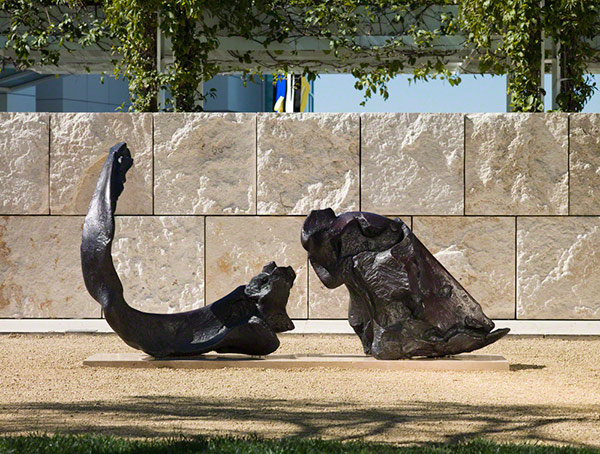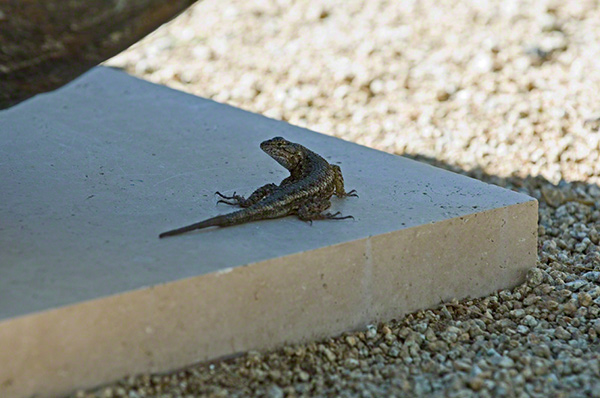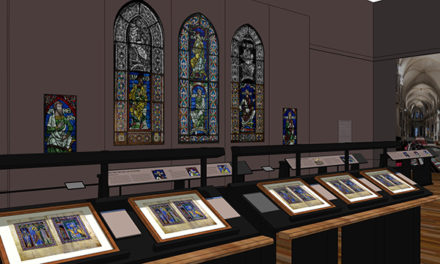
Big Skull and Horn in Two Parts II, 1963, Jack Zajac. Bronze, 44 3/4 x 92 x 22 1/2 in. The J. Paul Getty Museum, Gift of Fran and Ray Stark, 2005.123. Artwork © Jack Zajac. Photo: Tahnee Cracchiola
Throughout 2013, the Getty community participated in a rotation-curation experiment using the Getty Iris, Twitter, and Facebook. Each week a new staff member took the helm of our social media to chat with you directly and share a passion for a specific topic—from museum education to Renaissance art to web development. Getty Voices concluded in February 2014.—Ed.
“Keep your love of nature, for that is the true way to understand art more and more.” —Vincent Van Gogh
“Lucky shot” is actually a real thing that happens while shooting outdoors. You can plan your full day, have a shot list, track the sun, the moon, and the stars…but always be open to the unexpected, because that’s the key to capturing that shot.
My name is Tahnee Cracchiola and I’m a photographer at the Getty Villa. I was originally hired in June 2006 to photograph 28 selected sculptures that were gifted to the Getty Museum by Fran and Ray Stark. Nine locations throughout the grounds of the Getty Center were meticulously designed to house these sculptures.

As an architecture and outdoor sculpture photographer, my primary focus was conveying the journey of each sculpture from conservation to final installation. I charted the sun and the moon for the best lighting conditions for each sculpture and its location at sunrise, sunset, moonrise, and moonset (moonset can be really cool during a full moon) until I was able to capture the best lighting for each sculpture’s final in situ beauty shot for publication. It was truly a labor of love.
It became part of my routine to visit several sculptures a day to photograph them in their best light and time of year, as well as weather conditions. On one particular summer morning, when the heat was already radiating off the travertine sanctuary of the Getty Center, I heard a strange sound coming from Jack Zajac’s sculpture Big Skull and Horn in Two Parts II. It was like a scuffling sound…when all of a sudden out popped this little lizard! His entrance into my frame startled me, and at the same time his presence was surprising, because I had yet to see any kind of wildlife on the Getty grounds—including birds.

Artwork © Jack Zajac
My first instinct was to shoo him away because he was invading my shot, right? He was ruining my art!
A little background on this thought. As architecture photographers, we have a core understanding that the scene be flawless and pristine. It’s regular practice to pick up trash and move trashcans out of the frame. We use chairs and umbrellas as design elements and make very serious decisions on whether they should be open or closed. This attention to detail is even more exaggerated when shooting for a museum. Museum photographers often work closely with conservators and the facilities crew to make sure the outdoor art and surroundings have been cleaned and perfectly manicured. So here I was, face-to-face with this little intruder who wasn’t afraid of me and was not going to be intimidated out of his home. In fact, the more I protested his presence, the more he pranced around and posed for me. And so our relationship began.

Artwork © Jack Zajac
Every morning during my 10-minute break, I would stop by Zajac’s sculpture to visit with my Sculpture Buddy. As soon as he saw me he would shuffle to the edge of the travertine of the sculpture’s base and hang out soaking in the sun across from me. I would drink my morning coffee and he would just stand there blinking at me. It was refreshing and humorous to spend a little time photographing a lizard. He brought levity to my day and helped me feel grounded to the process of photographing outdoor art. I realized during our moments together that our connection was a deeper lesson for me regarding my profession and the scope of my work at the Getty: I needed to reevaluate my ties to this traditional view of photographing architecture and outdoor sculpture. If you’re going to install works of art outdoors, be prepared that the wild of the great outdoors just might make a cozy home out of it.

So I learned that summer from my Sculpture Buddy that it wasn’t just about evaluating the light and time of day and year to take the best photograph of an object. It is much more than that, and even extends beyond the lizard living in the Zajac. It touches how we view shooting outdoors as a whole. The true beauty of outdoor sculpture, landscape, and architecture is not only how the art reflects the colors and sites surrounding it, but also how wildlife utilizes the art resources for shelter, food, and entertainment. Each object is a slave to its environment. And then it finally hit me: the intruder was not the lizard…it was me.
I took this concept seriously and brought it with me to the Getty Villa, where I was assigned the following year to photograph the plant life and surrounding gardens for the book Gardens and Plants of the Getty Villa. I had no idea that what awaited me were more adventures as other wildlife at the Getty crossed my frame unexpectedly. This connection has extended from that first encounter with the lizard to hummingbirds, deer, butterflies, and other wildlife living at the Getty Villa.
The most fascinating realization for me was that they all were as interested in me as I was in them. They even seemed to pose for me—allowing me this exquisite moment to share in their life of playfulness, curiosity, and pure nature. And in turn I was given the opportunity to celebrate them with my photographs.
Connect with more “Getty Gone Wild” content:
- Tahnee talks about her experience shooting in the ‘wild’ and shares photographs from the series Waltz of the Hummingbird
- The Villa’s Outer Peristyle is a beautiful blend of architecture and garden magic. Tahnee discusses how her love of architecture influences choices she makes when photographing outdoors.
- Get a behind the scenes glimpse into the Villa photography studio as they photograph an attic pot
- Tips for shooting architecture in the field
- Tahnee shares her encounter with a young buck in the Getty wilderness
- A moving tribute to the Getty Villa grounds crew, a talented and passionate group of gardeners that made Tahnee’s work in the gardens an overwhelming joy
- Photographs of a mallard in the fountain of the outer peristyle that waited for his mate (who tragically never arrived)




What a remarkable journey of enlightenment, and a sweet reminder of how intertwined we are with nature. We really are just visitors in the world around us, and I think we lose sight of that with all of our attempts to build and “invade” the beauty. Keep on documenting the beauty with your precise eye. It helps the rest of us to understand by seeing it through your lens.
Hi, Lynn. Thank you for such beautiful words. You made my day! I’m so glad you like the images. Come visit The Iris tomorrow. I’ll be sharing a series of images called, ‘The Hummingbird Waltz’ that I know you’ll enjoy.
Wonderful!
Thank you, for sharing your “Labor Of Love,” Lulu. I enjoyed every minute. What an inviting habitat for your sweet Sculpture Buddy.
Hey, Mom! So nice to see your post. Thank you. Love you.
Very Special!!! Beautiful !!! Wonderful!!!
Nice! Check out Facebook tomorrow for the next photo series that I know you’re going to love. It’s called “The Hummingbird Waltz.”
Wonderful photos and articles, so inspiring to read and see. It’s Divine Mother talking to us through nature!
It’s a nice reminder today on Earth Day and for everyday. Thank you, Robyn, for your words and support.
I also work at the Getty Center and take walks to visit with wildlife here whenever I can get away from my desk. Last spring hummingbirds built nests in the Pride of the Madeira plants in the GRI’s interior balcony (looking over the eucalyptus garden). It was great to see them. Keep it up!
Hi, Teresa. Thanks for sharing your experience with the hummingbirds at the Center. It’s nice to hear that birds are establishing themselves around the site. Today we’ll be sharing on Facebook and Twitter hummingbird photos taken at the Getty Villa. It’s so exciting to see these birds in action.
Beautiful photos and comments. Looking forward to more. Much love, AB and UJC
Beautiful article!
Art is a collaboration between God and the artist, and the less the artist does the better.
Andre Gide
Dear Tahnee,
What wondrous work yours is and I shall be following you and your “new friends.” Indeed we are the intruders as often I do see a bald eagle perched on a side bar at the North end, or a deer on the heliport at the Center. Never is my camera with me. But I steel these mental views as serious notes to share with the visitors..and they are always in awe. You are a gift. Thank you for this prose and art.
EJ! You make me all weepy…thanks for your post. Will you bring your camera next time? I would LOVE to see an image of a deer on the heliport. What a dichotomy that would be!
What an enjoyable read! Thank you for bringing the pieces to life in these wonderfully captured potraits!
Hey Tahnee, Ireally love your work and am truly proud of you.
Love Dad.
Hi Dad…thanks so much. That means the world to me. I’ve been inspired by your care and love of nature all my life. Love you!
Tahnee, These are absolutely beautiful. You have such a gift. I can’t wait to show John and the boys these amazing images. Thank you for sharing:).
Hi! It’s so nice to hear from you. I’m glad you like the photos. This has been a great gift to be able to share my work on this forum. Please give my love to the family!
Beautiful, Tahnee. I want to enjoy morning coffee w a buddy like that 😉
Hi, Wonderful essay and photos. That lizard! Reminds me of the birds in my garden. Some of them follow me and twitter continuously as I putter around the flower beds. Such a glorious expereince.
Luz, you’re absolutely right about all the sounds in the gardens around us. My youngest daughter always reminds me to listen. In her sweet little two-year-old voice she’ll say, “I hear something!” She’ll stop and put her hand to her ear. She then exclaims, “I hear a bird Momma! A bird!” Such a simple thing that brings so much joy.